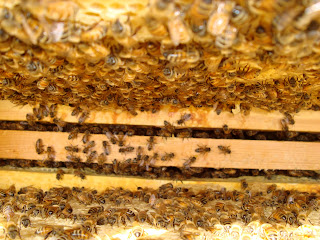September 23, 2011 .
As I report today on the first day of autumn, I have witnessed the loss of a colony in less than 3 weeks. It is very puzzling because this green little hive gave us a good super of honey this year, about 40 lb. This hive, Chanhassen #1 was "born" on April 20 2010 and was still a strong hive on August 27, 2011. Everything was perfect all summer, good brood pattern, lots of eggs, good queen, happy hive.
This is the hive we moved a few feet away to expose it to more sunshine. This is the hive which its occupants stung Ben 25 times! We know it was alive and well! How did it just die without a fuss, without giving us hints?
To be honest I had noticed some weeks ago, few honeybees with deformed wings but not enough to get alarmed. This happens in nature, and it is usually taken care of by the honeybees themselves; they remove diseased bees, pushing them out of the colony. Furthermore, I did not see any mites which can lead to diseases or viruses. A puzzle of grand proportion.
A weekend ago (Sept. 11) , Liz a friend came along to help us with our weekly honey bees' chores and like us she saw with sadness the pillage occurring. Many yellow jackets , paper wasps and bald-faced hornets were trying to get into the hive, attracted by the honey accumulated and robbing it. The small contingent of honeybees seemed powerless to defend themselves. They were however fighting fearlessly, dying to prevent the intruders to come in. Many died fighting, their cadavers were scattered in front of the colony. It was a very gloomy scene.
I needed to see more, I proceeded to open the hive to find a small amount of bees 200-300 many of them having deformed wings (DW). There is a virus called "deformed wing virus" that is vectored by the vireo mites, but I could not see any. Still a mystery....
I took a frame of dead brood with a few half emerged bees on it, as if no one was there to help them come to the world. I kept saying how sad it was to see this. The words in my head were echoing...how could that be possible, that fast with no warning signs that I could have seen? It was devastating. After a few minutes, I got out of my torpor and decided to do something about it. I could not save the colony but I could try to find out what had happened. I collected few dead honeybees, and put everything in plastic bags. I also kept the doomed frame. In addition, even if I knew the colony would not survive I could not let the invaders kill them mercilessly. I decided to close all the possible entrances with cork plugs and make the tiniest opening as I could for the honeybees to get into their hive, a safe place. I thought that at least they would die inside among their precious honey, and among themselves.
Now that I had regain some mental strength, I made the decision to bring all my specimen to the University of Minnesota and have them analysed. I have to know what happened. Judy ( A PhD entomology student at the U) and I will take a look together using her expertise and the tools available to us in our lab. We will try to solve this enigma. Someone has to know what happened to that colony. I really hope to have answers soon.
In the meantime, I am feeding the rest of the colonies with heavy Syrup 2:1. This helps them as the winter is coming soon, and the nectar available is very scarce. Plants are drying, and pollen is reduced. We help our bees the best we can, and know. It is always difficult to lose a colony but maybe we will learn something that will make us better beekeepers. You see I love my bees.
 |
| Honeybees with deformed wings |
 |
| Honeybee with deformed wings |
 |
| Yellow Jacket (vespula) |
 |
| Paper wasp (Polistes) |
 |
| Bald-faced hornet (D. maculata) |




















































